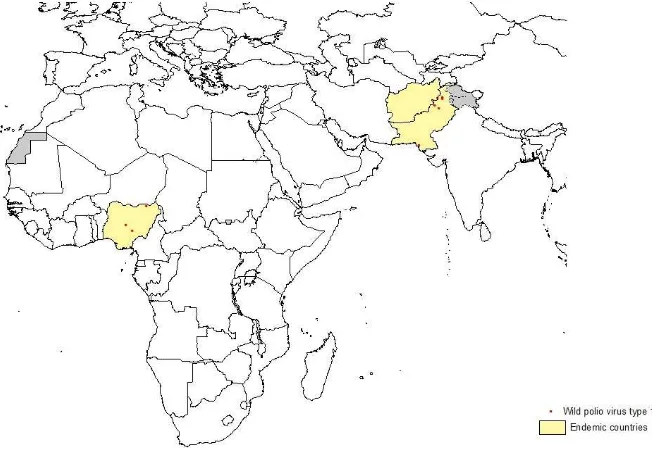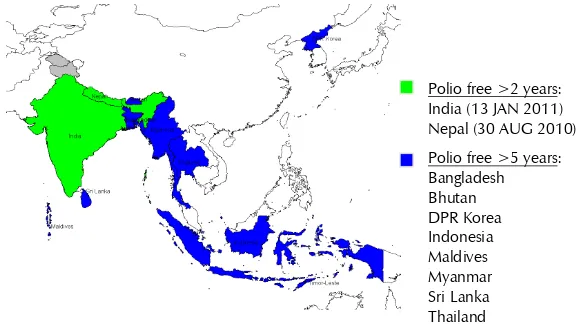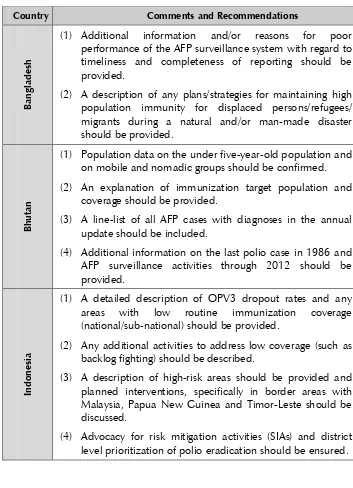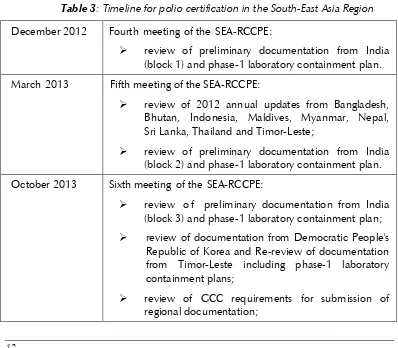South-East Asia Regional
Certification Commission for Polio
Eradication (SEA-RCCPE)
SEA-Immun-75 Distribution: General
South-East Asia Regional
Certification Commission for Polio
Eradication (SEA-RCCPE)
©World Health Organization 2013
All rights reserved.
Requests for publications, or for permission to reproduce or translate WHO publications – whether for sale or for noncommercial distribution – can be obtained from Publishing and Sales, World Health Organization, Regional Office for South-East Asia, Indraprastha Estate, Mahatma Gandhi Marg, New Delhi 110 002, India (fax: +91 11 23370197; e-mail: [email protected]).
The designations employed and the presentation of the material in this publication do not imply the expression of any opinion whatsoever on the part of the World Health Organization concerning the legal status of any country, territory, city or area or of its authorities, or concerning the delimitation of its frontiers or boundaries. Dotted lines on maps represent approximate border lines for which there may not yet be full agreement.
The mention of specific companies or of certain manufacturers’ products does not
imply that they are endorsed or recommended by the World Health Organization in preference to others of a similar nature that are not mentioned. Errors and omissions excepted, the names of proprietary products are distinguished by initial capital letters.
All reasonable precautions have been taken by the World Health Organization to verify the information contained in this publication. However, the published material is being distributed without warranty of any kind, either expressed or implied. The responsibility for the interpretation and use of the material lies with the reader. In no event shall the World Health Organization be liable for damages arising from its use.
This publication does not necessarily represent the decisions or policies of the World Health Organization.
Printed in India
Maps disclaimer
Contents
Page
Acronyms ... v
1. Introduction ... 1
2. Global progress towards polio eradication ... 2
3. Recommendations from the meeting of the Independent Monitoring Board, Global Polio Eradication Initiative, London, 29–31 October 2012 ... 3
4. Progress of polio eradication in the South-East Asia Region ... 4
5. Recommendations for NCCPE ... 5
6. Recommendations for the WHO Secretariat ... 11
Annexes 1. Agenda ... 14
Acronyms
AFP acute flaccid paralysis
cVDPV2 circulating vaccine derived polio virus (type 2)
GBS Guillain–Barré Syndrome
GPEI Global Polio Eradication Initiative
ICMR Indian Council of Medical Research
IMB Independent Monitoring Board
LGA local government area
NCCPE National Certification Committee for Polio Eradication
NPSP National Polio Surveillance Project
OPV oral polio vaccine
RI routine immunization
SEA-RCCPE South-East Asia Regional Certification Commission for Polio Eradication
SIA supplementary immunization activity
SEARO Regional Office for South-East Asia
VDPV vaccine derived poliovirus
WHO World Health Organization
1.
Introduction
The fifth meeting of the South-East Asia Regional Certification Commission for Polio Eradication (SEA-RCCPE) was held from 4 to 7 March 2013 in Malé, Maldives. Dr Supamit Chunsuttiwat of Thailand chaired the meeting. In addition to the SEA-RCCPE members, there were representatives from WHO headquarters, Regional office and India Country office (NPSP), NCCPE, and the India-Laboratory Taskforce. See annexes 1 and 2, respectively for the agenda and list of participants of the meeting.
The fourth meeting of the SEA-RCCPE held in Bangkok, Thailand from 18 to 20 December 2012, studied the preliminary documentation submitted by the India-NCCPE. The following conclusions and recommendations were made:
(1) Based on the information presented by India on the first block of
19 “low-risk” states and union territories, the SEA-RCCPE believed that the AFP surveillance system in these areas is capable of detecting wild and vaccine-derived polioviruses. The SEA-RCCPE was convinced that the last case of wild virus was detected in 2007, and that there was no wild virus circulating in these areas.
(2) SEA-RCCPE still had concerns about population immunity and
the accumulation of susceptible population due to poor routine immunization coverage and low coverage during national immunization days and supplementary immunization activities.
(3) Additional efforts were needed to ensure that high population
immunity in these 19 states and union territories was maintained.
Report of the Fifth Meeting
2
2.
Global progress towards polio eradication
Significant progress was made by the global polio eradication programme in 2012, though polio remained endemic in Afghanistan, Nigeria and Pakistan. India was removed from the list of endemic countries on 25 February 2012 after being polio-free for more than a year. A t the Sixty-fifth World Health Assembly in May 2012, Member States declared
that “completion of polio eradication is a programmatic emergency for
global public health.”
Figure 1. Global distribution of wild poliovirus, 1 January―5 March 2013
©
South-East Asia Regional Certification Commission for Polio Eradication (SEA-RCCPE)
(cVDPV) type 2 case outbreaks in Afghanistan, Chad, Kenya, Nigeria, Pakistan and Somalia and two cases of type 3 cVDPV in Yemen.
Tragically, in December 2012, nine polio vaccinators were shot and killed while vaccinating children in Pakistan near KP, Peshawar and Karachi. Again in February 2013, nine polio vaccinators were shot and
killed in Nigeria’s northern state of Kano. The impact of these senseless acts of violence in Pakistan and Nigeria is still not clear, but polio vaccination activities in these areas are expected to be negatively impacted.
3.
Recommendations from the meeting
of the Independent Monitoring Board,
Global Polio Eradication Initiative, London,
29
–
31 October 2012
The Independent Monitoring Board (IMB) was formed in 2010 to review and monitor progress on the Global Polio Eradication Initiative
(GPEI). The main conclusions of the IMB at its meeting in London, 29―31
October 2012 included the recognition that there were fewer polio cases in 2012 than ever in history, with only 94 districts in four affected countries. The commitment to polio eradication is an unprecedented priority, mostly due to the WHO declaration of polio as a global public health emergency. The goal of eradicating polio was not achieved by 2012, but prospects of attaining the goal are brighter than ever. There continues to be a high risk of more cases in more countries in 2013, underscoring the high priority to reduce risks and maintain progress toward eradication. Ten specific comments and recommendations were made:
(1) International Health Regulations (IHR) should designate an
expert review committee to urgently issue, by May 2013, a standing recommendation to introduce pre-travel vaccination and vaccination checks in Afghanistan, Nigeria and Pakistan. No citizen from an endemic country should be allowed into any country without a valid vaccination certificate.
Report of the Fifth Meeting
4
2013. An update on priority goals and a progress report is to be presented at the IMB meeting in May 2013.
(3) An analysis of the relationship between the number and quality
of SIAs should be completed to guide decisions about the optimum interval between rounds.
(4) All district and local government-level polio committees and task
forces in endemic and infected countries should include a parent, representing all parents in the district.
(5) Every opportunity should be taken to pair other health
interventions with the administration of polio vaccine.
(6) A report on global vaccine supply should be provided at each of
the future meetings of the IMB.
(7) GPEI will establish a systematic process to capture lessons learnt;
some regional efforts are ongoing, for example, AFRO is planning to put together a best practices document.
(8) Intensive polio watch will be set up in polio-free countries at the
highest risk of importation and outbreaks. WHO should issue action plans for strengthening vaccination coverage and surveillance in these countries.
(9) India should plan for a simulation exercise to test readiness for emergency response, to begin in a randomly selected group of districts in mid-2013.
(10) A live web-cam video feed will be broadcast online from the
Nigeria Emergency Polio Operations Center, allowing IMB and other partners to observe and provide input at any time.
4.
Progress of polio eradication in the South-East
Asia Region
South-East Asia Regional Certification Commission for Polio Eradication (SEA-RCCPE)
type-3 polio case was reported from Pakur, Jharkhand in October 2010. Importation of poliovirus from neighbouring and distant countries continues to be a risk.
Figure 2: Status of polio eradication in the South-East Asia Region
* BAN – 2006 and NEP – 2010: WPV outbreaks from India importations
**Myanmar – 2007 type1 poliovirus outbreak in province Rakhine (district Maungdaw) bordering Bangladesh.
5.
Recommendations for NCCPE
Bangladesh, Bhutan, India (block II), Indonesia, Maldives, Myanmar, Nepal, Sri Lanka, Thailand and Timor-Leste submitted 2012 annual updates for the
RCCPE to review. The report from the Democratic People’s Republic of
Korea is pending.
The SEA-RCCPE reviewed each country report and made specific recommendations to improve the national certification process and documentation. General recommendations for all programmes are followed by National Certification Committee-specific recommendations (Tables 1 and 2).
Report of the Fifth Meeting
6
General programme recommendations:
(1) Overall population immunity must be ensured through high
routine immunization coverage and high quality SIAs to prevent circulation after importation of poliovirus and emergence of vaccine derived polio viruses (VDPVs). The minimum coverage at the national, state and district levels should be 90%.
(2) Functioning of a uniform and highly sensitive AFP surveillance
system to verify the absence of poliovirus and guarantee the timely detection and response to importations and VDPVs should be ensured.
(3) All National Certification Committees (NCCs) should review with
their respective national health authorities the current WHO recommendations for polio vaccination requirement for travellers. Regardless of age, all travellers to countries or areas with current or recent poliovirus transmission, or those who plan to attend mass gatherings with the risk of exposure to infected persons should be fully vaccinated (per International Health and Travel) against polio before departure.
(4) All NCCs should advocate with their respective governments to
support the IMB’s recommendation on the use of the IHR to
require polio immunization for travellers and to urge the WHO Director-General to move forward with the implementation of this recommendation prior to the Sixty-sixth World Health Assembly in May 2013.
General recommendations for NCC annual reports:
(1) An accurate explanation of the population immunity throughout
the country that includes a description of routine immunization coverage and any additional supplementary immunization activities (SIAs) should be ensured.
(2) Any immunity gaps (OPV3 coverage ≤90% national, ≤80%
district) should be thoroughly described, including any immunization activities planned to prevent circulation after importation of poliovirus and/or the emergence of VDPVs.
(3) It must be ensured that a detailed description of any process or
South-East Asia Regional Certification Commission for Polio Eradication (SEA-RCCPE)
(4) A clear description of cross-border areas and any bilateral/
multilateral collaborations to synchronize immunization and surveillance activities should be ensured.
(5) An updated copy of the national outbreak and preparedness
plan that includes source of vaccine (self-procurement, UNICEF) and licensure status (mOPV, bOPV, tOPV) should be provided as an annex to the annual report.
(6) A description of plans to test outbreak and preparedness plan
(i.e., simulation exercises) should be provided.
(7) All graphs/charts and maps should have clear legends.
(8) The Guillain–Barré Syndrome (GBS) rate should be calculated as
part of the non-polio AFP rate.
(9) A copy of the updated phase-1 laboratory containment
documents should be provided as an annex to the 2012 annual report.
(10) Reports should have an executive summary, and should be
signed by the NCC chairperson.
(11) A copy of the conflict of interest statement should be provided
to all NCC members to the WHO/SEARO secretariat.
Country-specific comments and recommendations:
India-specific recommendations are presented in Table 1 and recommendations for other Member States of the SEA Region in Table 2. Based on the recommendations from the third meeting of the SEA-RCCPE in August 2012, the NCCPE grouped the states and union territories of India into three blocks on the basis of polio epidemiology. States that did not report wild poliovirus for more than five years were designated Block 1, Low-risk. States that reported wild poliovirus in the previous
3–5 years were designated Block II, medium-risk. And states that reported
wild poliovirus within the past three years or were historically endemic states were designated Block 3, high-risk. The report on Block 1, low-risk
states was previously presented at the fourth meeting of SEA-RCCPE in
Report of the Fifth Meeting
8
Country-specific recommendations below also include comments on phase-1 laboratory containment activities. These activities include the survey and inventory of all national laboratories that contain infectious or potentially infectious polioviruses. The completion of phase-1 laboratory is a requirement for the NCCPE to submit its final national polio-free certification documentation. The final report on the phase-1 laboratory containment activities needs to be completed by December 2013.
Table 1. India Block 2, Medium-risk states specific recommendations
Country Comments and Recommendations
India (Bl
ock
II
)
(1) Based on the information presented by the India NCCPE on
the 12 states in Block 2, the SEA-RCCPE believes that the AFP surveillance system is capable of detecting polioviruses (WPV/VDPVs) and that there is no circulating poliovirus in these areas.
(2) Despite high performing SIAs, the RCC is concerned about
population immunity and the accumulation of susceptibles due to poor RI coverage in some areas.
(3) India NCC should provide additional information describing
population immunity (i.e. vaccination coverage surveys, immunization status of NPAFP cases, sero-surveys) to reassure the RCC that there is a low risk of outbreaks and circulation following importation of WPVs or cVDPVs.
(4) The RCC is concerned about the status of phase-1 laboratory
containment in India.
(5) Completion of phase-I laboratory containment is a
requirement for India to submit its national polio-free certification documentation. If not completed and verified by December 2013, the RCC cannot consider the India documentation and the regional polio-free certification will be delayed.
(6) India NCC should prepare documentation on Block 3,
South-East Asia Regional Certification Commission for Polio Eradication (SEA-RCCPE)
Table 2. SEAR country-specific recommendations (excluding India)
Country Comments and Recommendations
Ba
ngl
ades
h
(1) Additional information and/or reasons for poor
performance of the AFP surveillance system with regard to timeliness and completeness of reporting should be provided.
(2) A description of any plans/strategies for maintaining high
population immunity for displaced persons/refugees/ migrants during a natural and/or man-made disaster should be provided.
Bhut
an
(1) Population data on the under five-year-old population and
on mobile and nomadic groups should be confirmed.
(2) An explanation of immunization target population and
coverage should be provided.
(3) A line-list of all AFP cases with diagnoses in the annual update should be included.
(4) Additional information on the last polio case in 1986 and
AFP surveillance activities through 2012 should be provided.
Indon
es
ia
(1) A detailed description of OPV3 dropout rates and any
areas with low routine immunization coverage
(national/sub-national) should be provided.
(2) Any additional activities to address low coverage (such as
backlog fighting) should be described.
(3) A description of high-risk areas should be provided and
planned interventions, specifically in border areas with Malaysia, Papua New Guinea and Timor-Leste should be discussed.
(4) Advocacy for risk mitigation activities (SIAs) and district
Report of the Fifth Meeting
(1) A detailed explanation of the effects of the following issues
on the surveillance and immunization programme should be provided:
reversion to centralization from decentralization
governance and funding
high number of expatriate doctors and high health
staff turnover
(2) Advocacy for explanation of active surveillance should be
undertaken in all hospitals.
(3) NCC meetings and activities should be re-established in
2013.
M
ya
nmar
(1) Areas of poor access and poor immunization coverage and
plans to address them should be described.
(2) Information on the recent changes in the country’s routine immunization schedule should be provided and the impact on coverage assessed.
(3) A detailed description of any risk assessment and
cross-border activities should be provided.
N
ep
al
(1) Detailed description of 2012 NID and MR campaign +
OPV including coverage and target populations should be furnished.
(2) Non-polio AFP rate and a specified rate of GBS should be
included.
(3) Information on-hard-to reach populations and any specific
South-East Asia Regional Certification Commission for Polio Eradication (SEA-RCCPE)
Sr
i L
anka
(1) Further evidence of polio-free status despite low non-polio
AFP rate (review for accuracy) should be provided.
(2) Explanation of low performing areas (coverage or
surveillance) and the plan for improvement should be provided.
(3) An AFP surveillance review should be discussed and
planned in the report.
(4) Discussions should be held on getting up an active
mentioning the significance of Thailand’s fully accredited
regional reference laboratory.
(2) Further information should be provided on the expert
review committee’s discarded specimen data, clarifying if
any case(s) are VAPP.
(3) Any updated risk assessment for importation should be
and plans for any SIA to increase should be provided.
(2) Any additional surveillance or immunization data
(independent survey) that would increase confidence in the country polio-free status report should be furnished.
(3) Details of the specimen collection and transport process
and any plans for improvement should be submitted.
(4) Multi-lingual AFP surveillance guidelines and manuals
should be obtained.
6.
Recommendations
WHO should follow up the conclusions and recommendations of this meeting and prepare for the sixth meeting of the SEA-RCCPE planned for October 2013 as follows:
Report of the Fifth Meeting
12
(2) A letter should be addressed to the Government of India on the
proceedings of this meeting, highlighting the Commission’s
concerns regarding progress towards phase-1 laboratory containment.
(3) A meeting should be organized between the RCC Chair,
additional members of the RCC and appropriate representatives from the Government of India.
(4) The polio laboratory task force coordinator should be contacted
to follow up on monitoring of progress on the phase-1 laboratory containment and to ensure that there is an update during the sixth meeting of the SEA-RCCPE in October 2013.
(5) Implementation of the recommendations for the second block
and preparation for the third block should be coordinated with the NCCPE.
Table 3: Timeline for polio certification in the South-East Asia Region
December 2012 Fourth meeting of the SEA-RCCPE:
review of preliminary documentation from India
(block 1) and phase-1 laboratory containment plan.
March 2013 Fifth meeting of the SEA-RCCPE:
review of 2012 annual updates from Bangladesh,
Bhutan, Indonesia, Maldives, Myanmar, Nepal, Sri Lanka, Thailand and Timor-Leste;
review of preliminary documentation from India
(block 2) and phase-1 laboratory containment plan.
October 2013 Sixth meeting of the SEA-RCCPE:
review o f preliminary documentation from India
(block 3) and phase-1 laboratory containment plan;
review of documentation from Democratic People's
Republic of Korea and Re-review of documentation from Timor-Leste including phase-1 laboratory containment plans;
review of GCC requirements for submission of
South-East Asia Regional Certification Commission for Polio Eradication (SEA-RCCPE)
review of documentation from all Member States for
submission to the GCC.
February 2014 Seventh meeting of the SEA-RCCPE:
review of 2013 annual updates from Bangladesh,
Bhutan, Democratic People's Republic of Korea, Indonesia, Maldives, Myanmar, Nepal, Sri Lanka, Thailand and Timor-Leste;
review of full certification documentation from India
with phase-1 laboratory containment
documentation;
Regional Review Meeting on Immunization
14
Annex 1
Agenda
Polio eradication: Global overview/update
Recommendation of Independent Monitoring Board (IMB)
Regional update: Eastern Mediterranean Report
Preliminary documentation: India Block II (A)
Preliminary documentation: India Block II (B)
Preliminary documentation: India Block II (C)
Report on laboratories containment activities, India
Annual updates of national documentation and laboratory
containment activities on: Bangladesh, Bhutan, Indonesia, Maldives, Myanmar, Nepal, Sri Lanka, Thailand and Timor-Leste.
South-East Asia Regional Certification Commission for Polio Eradication (SEA-RCCPE)
Annex 2
List of participants
RCCPE Chairperson
Dr Supamit Chunsuttiwat Senior Medical Officer Department of Disease Control Ministry of Public Health Bangkok, Thailand
RCCPE Members
Dr Suniti Acharya Executive Director Center for Health Policy Research and Dialogue Kathmandu, Nepal
Dr Anthony Adams
Ex Professor of Public Health
National Centre for Epidemiology and Population Health
Australian National University Avoca Beach, Australia
Dr Abraham Joseph Director
The Christian Institute of Health Sciences & Research (CIHSR)
Vellore, Tamil Nadu, India
Prof Ismoedijanto Moedjito Professor of Paediatrics Department of Child Health Medical School Airlangga University Surabaya, Indonesia
Dr Ali Jaffar Mohamed Assistant Secretary-General
Arab League for Quality in Health Services Muscat
Sultanate of Oman
Prof Mahmudur Rahman Director
Institute of Epidemiology Disease Control and Research (IEDCR) & National Influenza Centre (NIC)
Dr Kyaw Nyunt Sein Fund Management Executive
Department of Disease Control Ministry of Public Health Nonthaburi, Thailand
Prof MR Khan Director
Institute of Child Health & Shishu Sasthya Foundation
Dhaka, Bangladesh
Dr Badre Raj Pande President
Nepal Health Economics Association Kathmandu, Nepal
Mr Phub Rinchhen Former Chief Administrator Department of Medical Services Institute of Traditional Medicine Services Ministry of Health
Thimphu, Bhutan
Report of the Fifth Meeting
16
Dr Abdul Azeez Yoosuf Consultant in Medicine Maya Clinic and Azmi-Naeem Medical Center
Malé, Maldives
NCCPE Members/Representatives
Dr Helio Guterres
National Hospital of Guido Valadares Dili, Timor-Leste
Laboratory Task Force India
Dr Jagdish Deshpande Director
Global Specialized Laboratory Enterovirus Research Centre Mumbai, India
National Polio Surveillance Project (NPSP) India
Dr Sunil Bahl
Deputy Project Manager New Delhi, India
Dr Sudhir Joshi
Medical Officer, Polio Certification New Delhi, India
WHO Headquarters
Dr Rudolf Tangermann Coordinator
Programme Monitoring and Operations Unit Department of Polio Operations and Research Geneva, Switzerland
WHO Maldives
Ms Aminath Shenalin National Professional Officer
Programme Implementation & Monitoring Malé, Maldives
Observers–MOH Malé, Maldives
Dr Aishath Aroona Abdulla Epidemiologist
Ms Nashiya Abdul Gafoor Public Health Programme Officer National Immunization Programme Health Protection Agency
Dr Abdulla Niyaf
Senior Consultant in Paediatrics ADK Hospital
Ms Fathimath Rasheedha Public Health Programme Officer Health Protection Agency
Ms Aishath Thimna Latheef Public Health Programme Officer National Immunization Programme Health Protection Agency
Ms Aishath Shudha Laboratory Technologist
Indira Gandhi Memorial Hospital
WHO-SEARO Dr Patrick O’Connor
Regional Adviser
Immunization and Vaccine Development
Dr Robert D Allison Consultant
Immunization and Vaccine Development
Dr Zainul Abedin Khan
The fifth meeting of the South-East Asia Regional Commission for Certification of Polio Eradication (SEA-RCCPE) was held from 4 to 7 March in Malé, Maldives. The primary objective of this Commission is to guide Member States through the certification process for polio eradication through impartial and transparent verification.
The purpose of the meeting was to review the annual reports from Member States and make recommendations to improve documentation for certification. The Region has made tremendous progress towards polio eradication and is currently on track for regional certification in February 2014.



